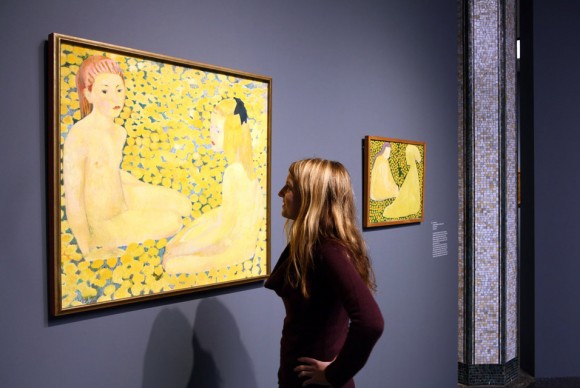Bucerius Kunstforum opens exhibition with works by Ferdinand Hodler and Cuno Amiet
January 29, 2012 by All Art News
Filed under Art Events & Exhibitions, Featured
HAMBURG.- Artistic friendships have always been an exciting mixture of friendship and rivalry. For the first time, an exhibition is being dedicated to the artistic interaction between Ferdinand Hodler (1853–1918) and Cuno Amiet (1868–1961). These were the two artists who shaped the Europewide advent of the modern art movement in Switzerland.
The exhibition focuses on the period after 1893 when the two artists encountered each other both in person and in the awareness of each other’s work. Although their relationship was characterized by quarrels and reconciliations, after Hodler’s death in 1918 Amiet could not lay it to rest, as seen here in the context of his posthumous homages to Hodler. Hodler was fascinated by Amiet’s brilliant palette and his loose painting technique. The younger Amiet admired the symmetry, ornamentation and linearity of Hodler’s works. However, Amiet’s paintings such as The Yellow Hill from 1903 (Kunstmuseum Solothurn), already display a potential that goes beyond Hodler. The painters of Die Brücke recognized this and included Amiet in their artistic group.

- A visitor observes the painting ‘The Yellow Girls’ by Swiss painter Cuno Amiet at the exhibition ‘Ferdinand Hodler and Cuno Amiet – An Artist’s Friendship between Art Nouveau and Modernism’ at the Bucerius Kunstforum art gallery in Hamburg, Germany. The exhibition features works of the two artists until 01 May 2012.
Friendships between painters have always been an exciting mixture of camaraderie and rivalry. Here for the first time, an exhibition takes a look at the creative interaction between Ferdinand Hodler, who was born in 1853 and died in 1918, and Cuno Amiet, who was 15 years younger than Hodler, but who outlived him by many years. Amiet died in 1961. Both of these artists shaped the beginnings of European modern art in Switzerland in their own unique ways.
This show compares key works by the two painters and illustrates how Amiet’s confrontation with Hodler enabled Amiet to find his own voice. The exhibition focuses on the period after 1893 when the two artists became acquainted with each other both in person and in their awareness of each other’s work. Hodler was fascinated by Amiet’s brilliant palette and his flowing painting technique. The younger artist admired the symmetry, ornamentation and linearity of Hodler’s work. In the minds of many contemporaries, Amiet was eclipsed at times by Hodler who was celebrated as the national artist of Switzerland. However, Amiet’s paintings such as The Yellow Hill from 1903 and The Yellow Girls from 1905 display a potential that goes beyond Hodler. The painters of Die Brücke recognized this and included Amiet in their artistic group in 1906. Although their relationship was characterized by quarrels and reconciliations, after Hodler’s death in 1918 Amiet could not lay it to rest, as seen here in the context of his posthumous homages to Hodler.
The exhibition has been divided into seven sections according to subject matter to contrast works with the same motifs created by both artists: self-portraits, paintings of trees, gardens, mountain panoramas, symbolic images of figures and portraits. In the center section on the ground floor you can see a group of works by both artists that show a direct reciprocal influence in terms of technique and motif: Hodler’s Spring and Amiet’s The Yellow Girls. Here you can see several versions and studies of both works.
This exhibition marks the 50th anniversary of Cuno Amiet’s death and has been designed in conjunction with the Kunstmuseum Solothurn, which holds the most prominent collection of paintings by Amiet. It was created in collaboration with the Swiss Institute for Art Research in Zürich. Loans for the exhibition come from major Swiss museums and numerous private collections.
This exhibition has been designed in conjunction with the Kunstmuseum Solothurn which holds the most prominent collection of Amiet’s paintings. Loans for the exhibition come from major Swiss museums and numerous private collectors.
Related posts:
- Sotheby’s Zurich sale of Swiss Art to present a major landscape by Ferdinand Hodler
- A major landscape by Ferdinand Hodler sells for CHF 7,138,500 at Sotheby’s Zurich
- Hauser & Wirth Opens an Exhibition of Works by Subodh Gupta
- Exhibition of new works by artist Gordon Cheung opens at Alan Cristea Gallery
- Marianne Boesky Gallery Opens First Exhibition of the Works of Alighiero Boetti
